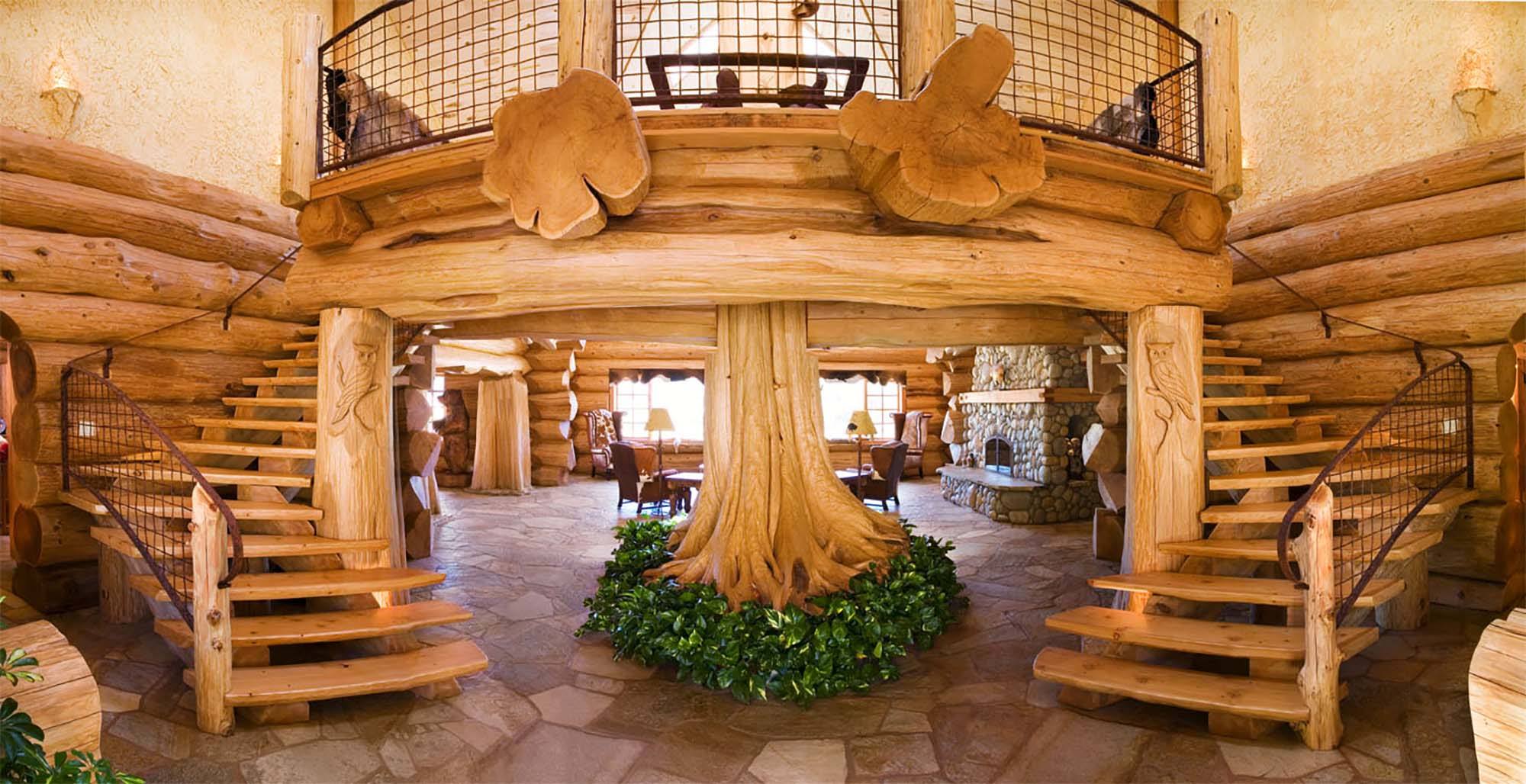The aesthetic that I chose to dive deeper into was the rustic aesthetic. This aesthetic takes inspiration from 17th and 18th century rural architecture, and focuses heavily on natural woods and stones. Rustic architecture was popularized in the United States during the mid 1800’s my landscape architect Andrew Jackson Downing.
There are many components that can fall under the umbrella of rustic, however one of the most prominent is the use of logs and unfinished wood.

Rustic houses will often have wood displayed on walls or on tables that looks very weathered and natural, often times including this like nail holes as seen above. These characteristics give it a older feel, and often involve using repurposed wood to emphasize the aged look. The rustic aesthetic is meant to feel comforting by being raw and unchanged, allowing the imperfections of a piece to be part of its appeal.

The image above uses full trees as beams, and rough cuts of logs on the stairs on the wall, which gives the space an incredibly natural feel, and leaves lots of room for creative expression since there is little need to worry about things like perfect symmetry or right angles. One thing I love about the rustic aesthetic is that it can be incorporated into very high end and fancy designs as well as basic and simple ones.

Old simples homes and cabins often encapsulate the rustic aesthetic since their design is the inspiration for the aesthetic. The goal of many modern rustic art pieces is to emulate the styles that hunters and trappers would have used hundreds of years ago, which sometimes involves updating those old cabins as seen above.

Another common component of rustic styles are rough exposed stone. This is often represented in homes in ornate fireplaces that appear handmade, and welcoming. The grays, blacks, and browns of the stone often contrast very nicely with the lighter shades of wood, making them mesh well together in the same environment.
While I have largely focused on the full designs of rooms or homes, the rustic aesthetic can also be applied on much smaller scales. Things such as tables and chairs, benches, and general décor can all fit into the rustic aesthetic. These types of things will often incorporate the same rough woods and stone with other animal related things such as hides, antlers, and leather. These all contribute to making the piece feel older, handcrafted and more relatable.


The above image combines the wood stone and animal aspects, while also including another common part of the rustic aesthetic in imperfect metal. The common theme seen in all of these images however, is embracing the beauty that is found in the imperfections of nature, and trying to recreate that beauty in ways that are functional for the modern world, while also invoking feelings of living in the past.
Sources:
https://aesthetics.fandom.com/wiki/Rustic
https://www.thespruce.com/what-is-rustic-design-4771798#:~:text=Rustic%20interior%20design%20is%20characterized,handcrafted%20raw%20and%20natural%20materials.
Images in order of appearance:
https://img.pikbest.com/wp/202344/rustic-vintage-woodgrain-embracing-the-aesthetic_9906590.jpg!w700wp
https://i0.wp.com/nationalland.com/blog/wp-content/uploads/2016/05/doublestairs.jpg?fit=2000%2C1028&ssl=1
https://blog.bairdbrothers.com/wp-content/uploads/2024/03/A-modern-log-cabin-living-room-with-a-stone-fireplace-and-wooden-mantel.-2.jpg
https://www.fredricksonmasonry.com/post/cozy-stone-fireplace-designs-for-your-prior-lake-home
https://logfurnitureplace.com/media/catalog/product/cache/1044726d93dd0fc5b52ac7ed430bb624/0/1/01-chair_16947.jpg
https://paseoroad.com/cdn/shop/collections/03191dc0c735c44f597060caacac8a3b_1200x803.jpg?v=1704472623

4 Comments. Leave new
Your description that this aesthetic embraces natural imperfections and what specific materials are used is very informative and captures the essence of this aesthetic. I think it could be worth further considering metal as a material in this aesthetic. It seems to me that a rustic aesthetic utilizes metal very little but the type of metal and how it is polished is an important thing to consider. I wonder if the metal in these designs is more focused on functionality and not necessarily the look.
From what I researched, the metal would be more for looks the majority of the time, as the rustic aesthetic tries to emulate the old and weathered look.
I enjoyed your post about the rustic aesthetic and particularly liked that you explained how each photo fit the aesthetic style. However, I was a bit confused about what “updating those old cabins” to fit modern rustic art referred to. I would appreciate it if you could provide more details around how old cabins have been updated/changed.
Additionally, I liked the inclusion of different features of the style and how the rustic aesthetic can be both high-end or basic. I was wondering if the difference between high-end and basic designs would effect the way the aesthetic is presented and would be interested in a deeper comparison. For example, do high-end designs tend to use different material types?
To clarify the old cabin comment, the designer renovated an old cabin, but made sure to keep many older and original components of the cabin to enhance the rustic aesthetic of it. From the research I did, I don’t think higher end designs would really use much different types of materials, just be bigger, and generally more detailed.